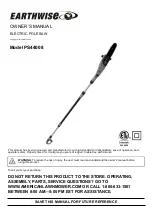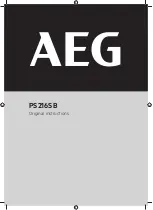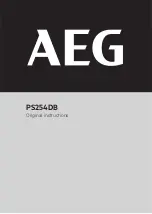
3
5.
DO NOT USE IN DANGEROUS ENVIRONMENT.
Do not use power tools in damp or wet
locations, or expose them to rain. Keep work
area well lighted. Do not use tool in presence
of flammable liquids or gases.
6.
KEEP CHILDREN AWAY. All visitors should be
kept safe distance from work area.
7.
MAKE WORKSHOP KID PROOF with padlocks,
master switches, or by removing starter keys.
8.
DO NOT FORCE TOOL. It will do the job better
and safer at the rate for which it was designed.
9.
USE RIGHT TOOL. Do not force tool or attachment
to do a job for which it was not designed.
10.
WEAR PROPER APPAREL. Do not wear loose
clothing, gloves, neckties, rings, bracelets, or
other jewelry which may get caught in moving
parts. Nonslip footwear is recommended. Wear
protective hair covering to contain long hair.
11.
ALWAYS USE SAFETY GLASSES. Also use
face or dust mask if cutting operation is dusty.
Everyday eyeglasses only have impact
resistant lenses, they are NOT safety glasses.
12.
SECURE WORK. Use clamps or a vise to hold
work when practical. It's safer than using your
hand and it frees both hands to operate tool.
13.
DO NOT OVERREACH. Keep proper footing
and balance at all times.
14.
MAINTAIN TOOLS WITH CARE. Keep tools
sharp and clean for best and safest
performance. Follow instructions for
lubricating and changing accessories.
15.
DISCONNECT BATTERY FROM TOOL before
servicing; when changing accessories such
as blades, bits, cutters, and the like.
16.
REDUCE THE RISK OF UNINTENTIONAL
STARTING. Make sure switch is in off position
before inserting battery.
17.
USE RECOMMENDED ACCESSORIES.
Consult the owner's manual for recommended
accessories. The use of improper accessories
may cause risk of injury to persons.
18.
NEVER STAND ON TOOL. Serious injury could
occur if the tool is tipped or if the cutting tool
is unintentionally contacted.
19.
CHECK DAMAGED PARTS. Before further use of
the tool, a guard or other part that is damaged
should be carefully checked to determine that it
will operate properly and perform its intended
function - check for alignment of moving parts,
binding of moving parts, breakage of parts,
mounting, and any other conditions that may
affect its operation. A guard or other part that is
damaged should be properly repaired or replaced.
20.
DIRECTION OF FEED. Feed work into a blade
or cutter against the direction of rotation of
the blade or cutter only.
21.
NEVER LEAVE TOOL RUNNING UNATTENDED.
TURN POWER OFF. Do not leave tool until it
comes to a complete stop.
22.
Ensure the switch is in the off position before
inserting battery cartridge.
Inserting the battery
cartridge into power tools that have the switch on
invites accidents.
23.
Recharge only with the charger specified by
the manufacturer.
A charger that is suitable for
one type of battery cartridge may create a risk of
fire when used with another battery cartridge.
24.
Use power tools only with specifically
designated battery cartridges.
Use of any other
battery cartridges may create a risk of injury and fire.
25.
When battery cartridge is not in use, keep it
away from other metal objects like paper clips,
coins, keys, nails, screws, or other small metal
objects that can make a connection from one
terminal to another.
Shorting the battery
terminals together may cause burns or a fire.
26.
Under abusive conditions, liquid may be
ejected from the battery; avoid contact. If
contact accidentally occurs, flush with water.
If liquid contacts eyes, additionally seek
medical help.
Liquid ejected from the battery may
cause irritation or burns.
27.
Disconnect battery cartridge from tool or place
the switch in the locked or off position before
making any adjustments, changing accessories,
or storing the tool.
Such preventive safety measures
reduce the risk of starting the tool accidentally.
28.
Have your power tool serviced by a qualified
repair person using only identical replacement
parts.
This will ensure that the safety of the power
tool is maintained.
USB033-3
ADDITIONAL SAFETY RULES
DO NOT let comfort or familiarity with product (gained
from repeated use) replace strict adherence to slide
compound saw safety rules. If you use this tool unsafely
or incorrectly, you can suffer serious personal injury.
1.
Wear eye protection.
2.
Keep hands out of path of saw blade. Avoid
contact with any coasting blade. It can still
cause severe injury.
3.
Do not operate saw without guards in place.
Check blade guard for proper closing before each
use. Do not operate saw if blade guard does not
move freely and close instantly. Never clamp or tie
the blade guard into the open position.
4.
Do not perform any operation freehand. The
workpiece must be secured firmly against the
turn base and guide fence with a vise during
Summary of Contents for XSL01
Page 67: ...67 ...




































